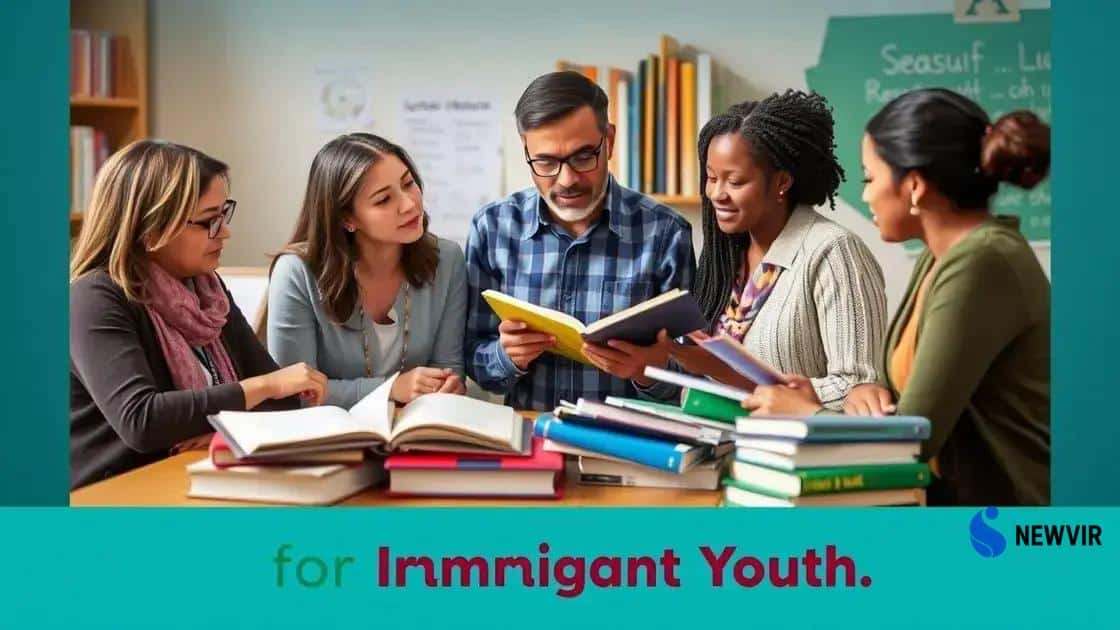Safeguarding educational rights for immigrant youth: a critical need

Safeguarding educational rights for immigrant youth involves advocating for equal access to education through community support, legal protections, and cultural awareness initiatives.
Safeguarding educational rights for immigrant youth is crucial, yet often overlooked. Have you considered how education can change their lives and future? Let’s dive into this important topic.
Understanding the challenges faced by immigrant youth
Understanding the challenges faced by immigrant youth is vital for helping them succeed. These difficulties can affect their education and overall well-being.
Common Challenges
Many immigrant youth face numerous obstacles. They often deal with language barriers, which can make schooling very difficult. Without proper support, they may struggle to keep up with their peers.
- Language difficulties hinder communication.
- Cultural differences can lead to isolation.
- Unfamiliar educational systems create confusion.
- Socioeconomic issues impact access to resources.
Furthermore, the feeling of cultural dislocation can cause stress and anxiety. Many students find it hard to adapt to a new environment while trying to maintain their identity. This conflict can lead to emotional challenges.
The Role of Schools
Schools play a significant role in addressing these issues. They can provide support through programs tailored to meet the unique needs of immigrant youth. Such programs often include language assistance, counseling services, and community outreach.
This type of support helps students understand the school system. It also fosters a sense of belonging, encouraging them to engage more fully in their education. Schools that create inclusive environments help to ease the transition for these young learners.
By recognizing these challenges, we can work together to find effective solutions and support systems. Understanding the barriers faced by immigrant youth is the first step toward ensuring they receive an equal educational opportunity.
The importance of education in immigrant integration
The importance of education in immigrant integration cannot be overstated. Education serves as a bridge that helps newcomers adjust to their new environment.
Building Language Skills
One of the first steps for immigrant youth is developing proficiency in the language of their new country. This skill is crucial not only for their academic success but also for daily interactions. Language classes often provide a foundation that enables students to communicate effectively. These classes can help them navigate schools, understand materials, and build friendships.
- Improved communication fosters social connections.
- Language skills help access necessary resources.
- Better understanding aids in academic performance.
Alongside language acquisition, education offers immigrant youth a structured routine and a sense of stability. Attending school brings predictability into their lives, which can be comforting in times of transition. The school environment can also promote a sense of belonging.
Fostering Cultural Awareness
In addition to learning a new language, education plays a role in fostering cultural awareness. Schools often celebrate multicultural events, helping students share their heritage and understand others. This exchange builds community bonds, making diverse classrooms rich with learning opportunities.
Understanding different cultures promotes respect and tolerance among students. It allows immigrant youth to feel valued and appreciated for their backgrounds. By participating in such initiatives, students can build confidence and pride in their identity.
Moreover, education equips immigrant youth with skills that enhance their futures. It provides access to resources such as counseling, mentoring, and extracurricular activities. These resources empower students to develop interpersonal skills and network with peers and mentors.
Legal frameworks protecting educational rights

The legal frameworks protecting educational rights are essential in ensuring that immigrant youth have equal access to education. These laws help guarantee that all students, regardless of their background, can pursue learning in a safe and supportive environment.
Key Legislation
Various laws exist that safeguard the educational rights of immigrant youth. One significant law is the Elementary and Secondary Education Act (ESEA), which mandates equal access to education for all children.
- Title I funds support schools in low-income areas.
- The Individuals with Disabilities Education Act (IDEA) offers protections for students with disabilities.
- The Immigration and Nationality Act ensures that no child is denied education based on immigration status.
Understanding these laws is crucial for parents and educators. They provide a framework for how schools must support immigrant students, helping to create inclusive classrooms. Schools should be aware of their responsibilities and the rights of the students they serve.
Enforcement and Support
Enforcement of these laws often comes from various government agencies. The U.S. Department of Education monitors compliance and investigates complaints. Additionally, organizations such as the American Civil Liberties Union (ACLU) advocate for the enforcement of educational rights, providing resources to help families understand their rights.
Moreover, schools can implement policies that embrace diversity and promote equity. Providing training for teachers and staff on cultural competency can better prepare them to assist immigrant students effectively. An inclusive environment not only improves educational outcomes but also fosters a greater sense of belonging.
Legal frameworks play a vital role in protecting educational rights, but awareness and advocacy are equally important. Engaging with these laws can lead to positive change and support for immigrant youth in their educational journeys.
Community initiatives supporting immigrant students
Community initiatives supporting immigrant students are crucial for their integration and success. These programs not only provide academic help but also foster a sense of belonging.
Types of Initiatives
Various community-based programs offer services tailored to the unique needs of immigrant youth. These initiatives may include tutoring sessions, mentorship opportunities, and after-school activities. Such programs can help students adjust to their new environment.
- Tutoring helps improve language and academic skills.
- Mentorship provides guidance and emotional support.
- After-school programs offer a safe space for socializing.
- Parent engagement initiatives help families connect with schools.
In addition, community organizations often collaborate with schools to host events that celebrate diverse cultures. These events not only showcase the rich backgrounds of immigrant students but also promote intercultural understanding among peers.
Building Networks
Another key aspect of these initiatives is the creation of support networks. Local organizations can connect immigrant families with resources such as health care, legal aid, and job training. Access to these services is essential for helping families thrive.
Moreover, community initiatives often encourage volunteer involvement from local residents. This engagement helps to build connections between immigrant families and the wider community. Relationships fostered through these efforts can lead to increased integration and support.
Supporting immigrant students through community initiatives not only benefits these young people but also strengthens the fabric of the community as a whole. When immigrant youth succeed, everyone benefits from their talents and perspectives. By fostering an environment that values diversity, we pave the way for a brighter future for all.
Strategies for advocating educational access
Strategies for advocating educational access are essential in ensuring that immigrant youth receive the opportunities they deserve. By employing various approaches, we can create a more inclusive education system.
Building Awareness
One effective strategy is building awareness about the challenges that immigrant students face. This can be done through community forums and workshops that invite educators, parents, and community members to discuss these issues. Awareness campaigns can help highlight the importance of providing resources and support for these students.
- Sharing stories of individual experiences can foster empathy.
- Information sessions can educate stakeholders about legal rights.
- Collaboration with local media can amplify advocacy efforts.
Moreover, engaging with local schools to provide training for teachers on cultural competency can significantly improve the learning environment. Educators who understand the unique backgrounds of their students can tailor their teaching methods to better meet the needs of immigrant youth.
Collaborating with Organizations
Another crucial strategy is collaborating with nonprofits and community organizations. Partnerships with groups that specialize in immigrant services can lead to shared resources and combined efforts in advocacy. These organizations often have established trust within communities.
By working together, we can create programs that provide tutoring, mentorship, and family support. These initiatives make it easier for immigrant families to engage with schools. Additionally, advocacy groups can lobby for policy changes that protect educational rights.
Using social media platforms to mobilize support is another effective strategy. Social media can spread awareness quickly and connect people who want to advocate for educational access. Online petitions and campaigns can rally community support for changes that will benefit immigrant students.
Combining these strategies creates a multifaceted approach to advocacy. By working together, communities can ensure that educational access is available for every immigrant child, paving the way for their success in school and beyond.
FAQ – Frequently Asked Questions about Advocating Educational Access for Immigrant Youth
Why is advocating for immigrant youth’s educational access important?
Advocating for educational access ensures that immigrant youth have equal opportunities to succeed in school and integrate into their community.
What types of community initiatives support immigrant students?
Community initiatives may include tutoring, mentorship programs, cultural events, and family engagement activities.
How can schools improve support for immigrant students?
Schools can provide training on cultural competency for teachers, offer language assistance, and create an inclusive environment that celebrates diversity.
What role do legal frameworks play in protecting educational rights?
Legal frameworks ensure that all students, regardless of immigration status, have access to education and protect their rights within the school system.






